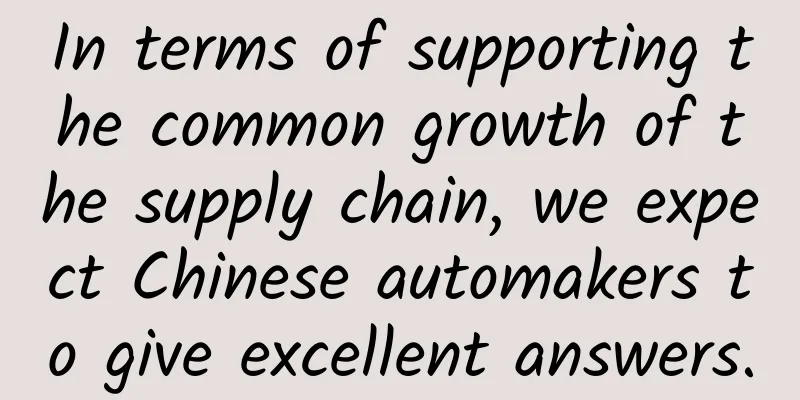In terms of supporting the common growth of the supply chain, we expect Chinese automakers to give excellent answers.

|
While you are hurrying along with your head down, you also need to look up and see the world. The competition in the current Chinese auto market has become an inevitable trend, but the large manufacturers and the supply chain are each "competing", which is ultimately not a win-win strategy. The OEMs ordered the supply chain to lower prices, and the attitude of the spare parts companies was "want to refuse but have no choice". Even if they sent a few "remote emails" they were just expressing "protest" and had little influence on the results. Some supply chains also responded that the company's overall scale and cash flow can only maintain normal operations. Once the company is required to reduce prices by 10%, it will fall into losses and will have no choice but to consider withdrawing from the OEM's supply chain system or trying to stop supplying to force the OEM to sell. It can be seen that in this price reduction storm, both sides are actually pushing the limits. Putting aside the attitude of car companies, large manufacturers, considering the competitive pressure, of course hope that the price is as low as possible. The same goes for spare parts suppliers. Regardless of whether the "unable to survive" is true or not, it is understandable that anyone who runs a business does not want to make more money. From the perspective of the development of China's auto industry, if the two sides suppress each other and even exploit each other, the entire market environment cannot be called healthy. If the big manufacturers and their own supply chain systems cannot have the same goals, there is no win-win situation at all. In fact, it is not the first time that large manufacturers and suppliers have fought each other and even intensified conflicts. Xu Shiqian, former marketing director of Magneti Marelli China and head of the automotive business unit of Dafu Technology, pointed out that some OEMs use their dominant position as chain leaders to force suppliers to agree to price cuts by delaying payment and imposing fines when negotiating supply prices. As early as 2018, some suppliers protested against the price reduction demands of a certain Li Automobile Group; in 2023, some parts suppliers also expressed dissatisfaction with the "withholding of payment" by a certain An Automobile. The "conflict" between car companies and parts suppliers in the domestic automobile market has been going on for a long time. Whether it is ADI or some other large manufacturers, netizens still feel that both sides are fighting on their own. In the international market, it is difficult to generate any competitive advantage. When it comes to the relationship with suppliers, there are big differences between the practices of overseas and domestic large manufacturers. In the early days, Toyota's supply chain has always been praised by the industry. It has achieved long-term and stable cooperative relationships through cross-holdings with suppliers such as Aisin and Denso, and has managed the supply chain with a "lean production method", which is regarded as a benchmark in the industry. This kind of relationship has a different incentive effect on suppliers. As Yuan Wenbo, global partner of Roland Berger, said, "Toyota has established a long-term and stable cooperative relationship with suppliers through systematic and continuous optimization. This relationship is based on risk sharing and benefit sharing, which encourages suppliers to invest in R&D and process optimization. Toyota's supplier relationship management strategy emphasizes partnership rather than simple transaction relationship. This strategic synergy enables Toyota to achieve more efficient cost control and technological progress in the supply chain. " In addition, Toyota has also gone overseas with its parts companies, actively building alliances and promoting vertical integration of the supply chain, which can achieve mutual benefit with suppliers while strengthening its own competitive barriers. Obviously, foreign car companies pay more attention to cooperation and win-win when dealing with suppliers. Not only Toyota, but Tesla also has a relatively harmonious relationship with its suppliers. More than 95% of the parts for Tesla's Shanghai Super Factory come from Chinese suppliers. Tesla Vice President Tao Lin publicly stated on Weibo that "Tesla's achievements in China and even around the world are inseparable from these partners. Only by achieving win-win results with supplier partners and increasing efficiency and reducing costs through technological innovation can the company go further, the industry can prosper, and consumers can continue to get the best products." In order to further reduce the cash flow pressure on suppliers, on November 28, Tesla Vice President Tao Lin posted on Weibo: "In 2024, the company's payment cycle to supply chain companies will be further shortened compared with last year, and now it only takes about 90 days." Zhang Xiaoliang, founder of So.Car Product Strategy Consulting, said, "Tesla will work with suppliers to challenge the goals of technology development and technical cost reduction, and will also send teams to participate in the collaborative R&D process of suppliers." It can be seen that the reason why many overseas brands have outstanding competitiveness in the Chinese market and the global market is closely related to their healthy supply chain system. Learning from others’ strengths can often help you grow faster. Although Chinese independent brands have certain competitive advantages in new energy technology, scale, and supply chain, at present, Chinese auto companies still have relatively weak experience in supply chain management. Using the simplest and crudest method of “price reduction” to treat suppliers obviously has many disadvantages. If this continues, the parts supply chain will have no profits, relations with OEMs will be tense, and growth will be limited. Ultimately, China's independent brands may be "bitten back" by current operations and find it difficult to gain broader development space in domestic and foreign markets. From the perspective of long-term interests, it is much better for Chinese automakers to improve brand competitiveness through technology and management cost reduction rather than crudely demanding price cuts. After all, if Chinese independent brands can only rely on lowering the prices of parts supply chain products to obtain capital for "price wars", it is difficult for us to expect them to go far in the global market. |
<<: The first generation iPhone sold at a sky-high price. Outdated electronic products = garbage?
>>: Japan develops microrobots: DNA controls movement like cells
Recommend
KMC Knowledge and Experience Extraction Online Training Camp, valued at RMB 4999
KMC Knowledge and Experience Extraction Online Tr...
Yun OS review: No wonder Meizu's Huang Zhang bet 10 million
Recently, Yun OS has been the hottest topic in th...
Come and see them “give birth” again in the spring breeze, and “give birth” to their babies!
Spring is here, and it’s the season when everythi...
Ogilvy's internal training on advertising creativity
In "Creativity is just incomprehensible? In ...
iOS 9: Getting Started with UIStackView
[[138778]] Like every previous iteration of iOS, ...
Winter is a nightmare for electric cars? BMW i3 leaks a lot, and converting oil to electricity is unreliable
When winter comes, it seems to be the time when e...
Is Yunnan welcoming the "blind box" season? 3,000 kinds of exotic "mushrooms" for you to choose from!
Yunnan Provincial Local Chronicles Compilation Co...
2020 full network marketing promotion methods!
Since the rise of online marketing, online market...
How to find the best selling point in 15 minutes? This is what the boss thinks...
Have you ever had this experience , your boss cal...
The deadly toxin "fumonisin" in cold noodles, in what other foods is it hidden?
Recently, the news that one woman died and the ot...
Core Animation Demos
Introduce the realization of various graphics and...
How to quickly build a marketing and promotion system for 2B products
In the past two years, the SAAS product market ha...
E-commerce cash back marketing campaign design!
"Are you there? Please help me!" We mus...
Why has the Japanese electronics industry, which once dominated the world, lost its legend after Walkman, and has no more star products?
In the 1970s, the Japanese government implemented...









